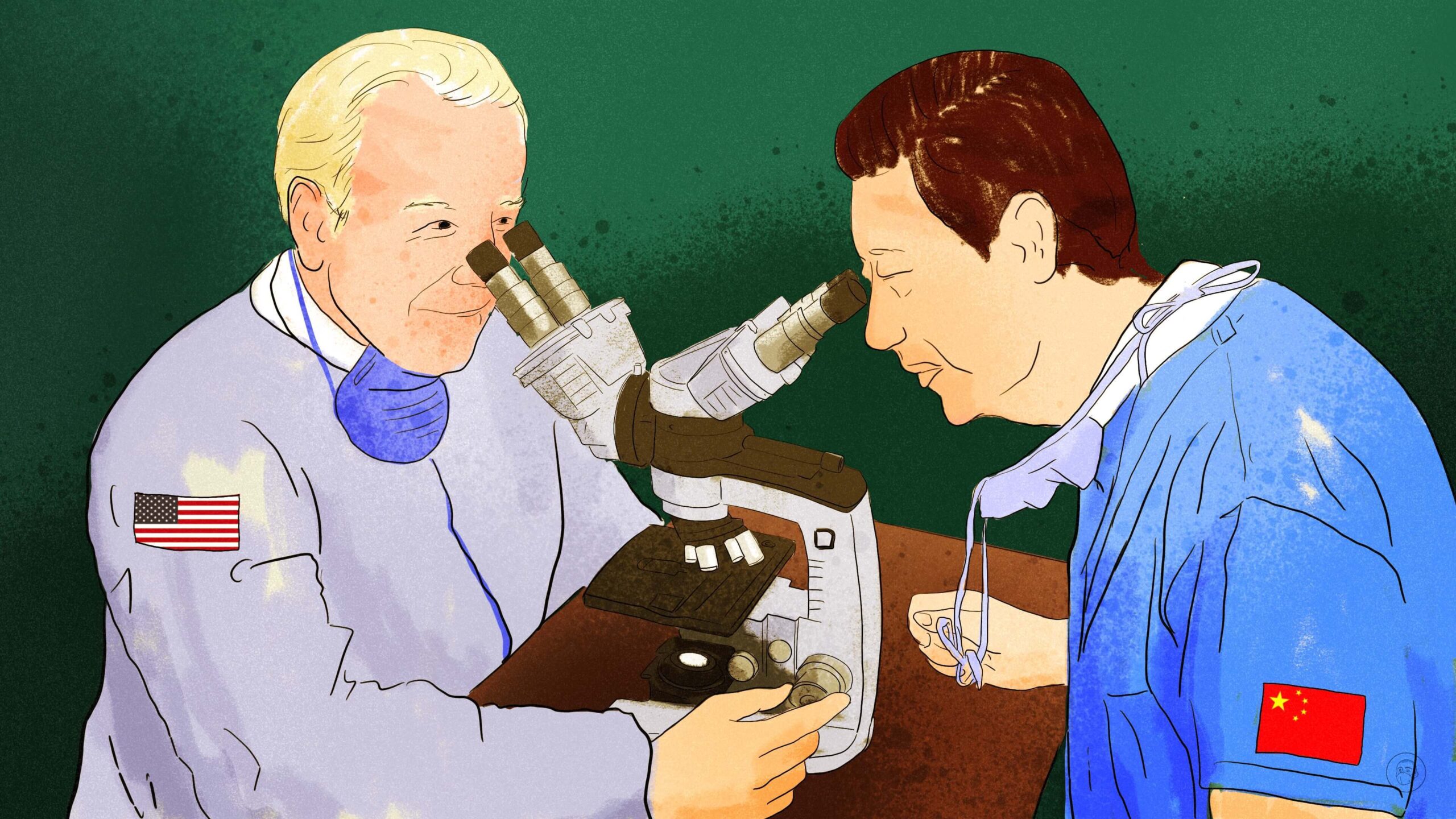Climate cooperation or tech clash: America can’t decide
Sino-U.S. science and technology partnerships can help or hurt both sides, depending if you’re talking to the faithful or the fearful.

John Kerry, the United States Special Presidential Envoy for Climate, tried to revive cooperation with the world’s largest emitter of greenhouse gas in talks with his Chinese counterparts in Beijing on Wednesday.
Kerry met Chinese Premier Lǐ Qiáng 李强, top diplomat Wáng Yì 王毅, Vice President Hán Zhèng 韩正, and Chinese climate envoy Xiè Zhènhuá 解振华 in meetings that began on July 17. (While Kerry was in Beijing, another former secretary of state, the 100-year-old Henry Kissinger, visited and was given red carpet treatment, including an audience with Xí Jìnpíng 习近平, who did not meet with Kerry.)
“We both agreed today to continue the bilateral engagement to address the climate crisis,” Kerry said in a press briefing after Wednesday’s talks. “We also both agreed to do so in the same terminology as a matter of urgency and in recognition of the global and existential nature of this crisis.”
China suspended climate cooperation in August 2022 in response to a visit to Taiwan by then U.S. House Speaker Nancy Pelosi. Beijing and Washington resumed informal climate talks in November at the COP27 summit in Egypt.
Is it possible to combat climate change together if scientific collaboration is banned?
But even as Kerry worked to get the U.S. and China realigned, lawmakers on Capitol Hill advanced legislation that would undermine the collaboration between American and Chinese scientists that experts say could be critical in slowing climate change.
On July 14, legislation that would prohibit U.S. federal departments and agencies from funding or supporting research in China passed a House vote as an amendment to the National Defense Authorization Act (NDAA).
The vote came amid protracted tension between the U.S. and China over issues ranging from U.S. controls on the export of American technology to China, a Chinese surveillance balloon that floated over the U.S. in February 2023, and Washington’s relations with Taiwan, the self-governed island Beijing considers a part of China.
For the Republicans’ amendment to the NDAA blocking climate change cooperation with China to pass, it must survive a vote in the Democrat-controlled Senate the week of July 24, 2023.
In addition to the amendment to the NDAA, in late June 2023, Representative Mike Gallagher of Wisconsin and nine other Republican members of the House called on the State Department to allow the expiration of the Scientific and Technological Agreement (STA) with China that the U.S. has renewed every five years going back to 1979, when Beijing and Washington first established relations.
The deadline to renew the STA is August 27. The State Department declined to comment on the likelihood the Biden administration will push to renew the STA.
The balloon still haunts U.S.-China ties
Republicans who want to stop scientific cooperation with China argue that Beijing may use what Chinese scientists learn from their American counterparts against U.S. interests, or in a military conflict.
As grounds to end the STA, Republican members of Congress cited a project between the National Oceanic and Atmospheric Administration and its Chinese counterpart, which they argued helped China develop its now infamous surveillance balloon.
In a letter to Secretary of State Antony Blinken, Republicans said that U.S. Department of Agriculture cooperation with China on drone and satellite imagery analysis had clear military applications.
Advocates for continuing and even increasing U.S.-China cooperation on science and technology say that the world’s two largest economies, and largest funders of scientific research, must collaborate to address climate change, pollution, and pandemics.
While cooperation under the STA continues today, it is diminished when compared with cooperation under previous U.S. administrations, especially on climate change, John Holdren, President Obama’s Director of the White House’s Office of Science and Technology Policy, told The China Project.
“These government-to-government collaborations on climate largely withered under Trump and have not yet been fully restored under Biden,” Holdren said. “I believe the STA could and should be instrumental in rebuilding them now.”
The total amount of money that the U.S. government puts toward scientific cooperation with Chinese entities is not clear due to limits on data sharing, according to a September 2022 report from the U.S. Government Accountability Office. The report reviewed activity from five government agencies, and concluded that the Centers for Disease Control and Prevention (CDC), the Department of Defense, and the National Institutes of Health provided a combined $28.9 million in funding to Chinese entities from 2015 to 2021.
But China is not cooperating with the U.S. in order to get its projects funded.
“China has a lot of science money,” Deborah Seligsohn, an assistant professor of political science at Villanova University, told The China Project from Beijing. “That’s no longer what the issue is. It’s that we often have complementary expertise, we often have shared scientific interests and goals.”
Global success stories of scientific cooperation
Cooperative projects under the STA have produced important successes beneficial to Americans. When the U.S. helped China control air pollution, for instance, it improved air quality along the U.S. West Coast as fewer pollutants drifted across the Pacific, Seligsohn said.
U.S.-China cooperation on a major, multi-decade study of birth defects conducted by the U.S. CDC and Peking University’s Health Science Center improved medical outcomes around the world, not just in China.
“Every single person in the world who has a baby today has a much lower probability that that baby will be born with spina bifida or hydrocephalus because of research that was done between the U.S. and China,” Seligsohn said. “If you go on the U.S. CDC website, the birth defects study is listed as one of its 10 great triumphs in the entire history of the U.S. CDC. And that’s done here in China.”
Seligsohn said that if lawmakers are concerned about dangers raised by specific areas of scientific cooperation between the U.S. and China, those areas could be discontinued without tearing up the broader umbrella agreement.
“For example, we would really like to figure out how to get rice fields to produce less methane so that we can reduce global warming,” Seligsohn said. “But we don’t have to work on drones anymore.”
In some cases, however, the areas most ripe for collaboration are also those that are likely to have national security implications.
“The key strategic mission here is that both sides have to work and think about this in two dimensions: Where are the gains from collaboration highest, but also where are the risks of political blowback lowest, and it’s that cell that one has to occupy,” said David Victor, a professor of innovation and public policy at the University of California, San Diego.
“One could imagine a lot of interesting things being done on advanced nuclear — I continue to think that’s an area of tremendous promise for the energy revolution,” he added. “But because of the way nuclear shades into the national security side, that’s going to be really, really hard to do.”
Access to Chinese research
In addition to improved health in both countries, collaboration offers U.S. researchers a valuable and increasingly rare view into a number of Chinese science and technology endeavors.
When it came time for the Trump administration to renew the STA in 2018, it did so partly in order to maintain this access, Denis Simon, a professor of strategy and entrepreneurship at the University of North Carolina, Chapel Hill, said.
“It wasn’t clear that the Trump administration was going to renew, but they decided to renew because their basic interest was in access,” Simon said. “They needed to maintain access to try to see what was going on and they realized that if they curtailed the agreement, their access might have been cut off.”
China today brings more to the table than it did when it was still catching up to the U.S. on science and technology.
“The irony of all of this is that we want to de-link with China at a time when China actually has something really to contribute to the game,” Simon said. “Access and cooperation have real meaning now, at a level that they never really had before.”
IP risks
In addition to the possibility that U.S. technical know-how could end up helping Beijing improve PLA military capabilities, it’s possible China may be taking advantage of collaboration to misappropriate patentable technology or research results from U.S. partners.
In some cases, when Chinese and U.S. researchers collaborated under the auspices of the STA, it was not always clear which researchers or organizations held the intellectual property rights related to research, said Mark Cohen, the director of the Berkeley Center for Law and Technology at the University of California, Berkeley, and a lawyer with decades of experience in IP law in China.
“These are complicated questions about where to file [the patents], how much money to spend, who is going to pay for it, who owns it, what’s the share between the U.S. and China, how to commercialize the technology, how to handle follow-on research that flows from the funded research, economic and national security implications, and how to enforce against any infringers,” he said. “Added to these ‘traditional’ concerns, there have also been newly arising issues, such as who owns or controls the underlying data.”
“I don’t think anybody’s actively managing all of the U.S. government-funded IP assets that arise from cross-border research to develop comprehensive strategies, or if they are, they’re barely managing it,” he added
Despite the potential risks, some still argue it’s worth engaging China when it comes to science and technology.
“The benefits of cooperation on climate change science and the technologies for climate change mitigation and adaptation — particularly by the world’s two largest emitters of greenhouse gasses — far exceed any liabilities,” Holdren said.
Canceling the Scientific and Technological Agreement also could further damage an already frayed relationship between Beijing and Washington at a time when both sides are expressing a desire to stabilize relations.
“The S&T Agreement has enormous symbolism and it has been my experience that the U.S. does not pay sufficient attention to symbolism,” Seligsohn said. “It’s going to have enormous meaning if we take it away.”






